APOLLWN
(Apollo)
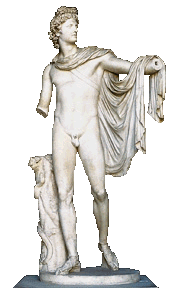
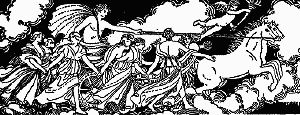

|
Roman Name: Apollo Sacred Cities: Delos and Delphi Totem Animals: Dolphins and Ravens His Plant: The Laurel Tree How to Identify Him: Check what he's carrying: bow and arrows, lyre, a laurel wreath, etc. |
The statue on the upper right is the famous "Apollo Belvedere," a 4th-century Greek statue that now survives only in a Roman copy housed at the Vatican Museum. The diagonal stripe you see across the right side of his chest is the strap that holds a quiver full of arrows on his back. The tree stump is there to hold the statue up. Marble is heavy! And yes, that is a snake, or rather a Python, you see coiled around the stump. Read on or see this week's assigned reading to find out why.
Notice that he has no beard. This is one way to tell a junior-generation Olympian from a senior. Apollo and Hermes are usually depicted without beards. The system isn't perfect: Hephaestus often has a beard, and Dionysus sometimes does and sometimes doesn't. But those two seldom look as shaggy as their heavily-bearded elders, Zeus and Poseidon. As for Hades, he usually isn't depicted at all. He's too scary. But when he is, there's that senior-generation beard.
The modern picture at the very top of the page, showing Apollo driving a sun chariot, is a lot more controversial. Although that is the standard image many people have of Apollo and he does indeed appear as the sun chariot driver in some ancient texts, that role originally belonged to a god called Helios. In later accounts Apollo sometimes becomes so conflated with Helios that he even inherits that famous "bad boy," Phaëthon (pages 332-333 in Harris and Platzner), as his son, though he never does inherit everybody's favorite "bad girl," Medea, who remains Helios's granddaughter (not Apollo's) in any text you consult. At the end of Euripides' tragedy about her, Medea escapes into the sky in a chariot bestowed upon her by Grandpa, though her chariot is pulled by giant snakes instead of celestial horses.
In fact, just what Apollo is the god of, or exactly where he came from, is a bit of a puzzle. As our textbook points out, nobody knows the prehistory of the worship of Apollo and some scholars think he is a Johnny-come-lately dating back no further than the twelfth century B.C.E. (well, for a Greek god, that is a Johnny-come-lately). Nobody knows where he got the names "far-darter" and "Phoebus" and there are even some debates about what those names mean, although these are by far the most common epithets that are given to him in ancient texts. An epithet is a descriptive name attached to the proper name of a person or god. Other popular epithets were "Gray-eyed Athena," "Zeus Thunderer," "Golden Aphrodite," and, to mention only one mortal, "Swift-footed Achilles." And my personal favorite, "Ox-Eyed Hera." That doesn't sound very flattering, but if you think about cows for a minute you'll realize that they really do have quite beautiful eyes. Plus Hera's totem animals are bovines, so that one makes sense on a couple of different levels.
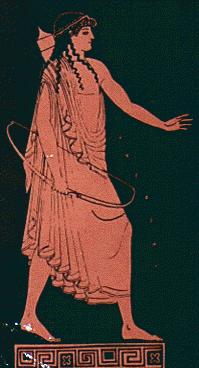 |
Another epithet, Apollo Smintheus, is usually defined as "Lord of Mice." The connection with mice is by no means certain; all we know is that the epithet does seem to have something to do with plague, but that's because of its connection with the prayer of Chryses that brings the plague down on the Greek troops at Troy (see below). Since the word Smintheus is found only in Homer, we have no other text to compare it against. Possibly the certainty that "Lord of Mice" is the correct meaning could be colored by our own knowledge that mice and rats bring plague--for instance, the bubonic plague in the medieval period that was spread by fleas carried on rats. Although ancient medicine was much more advanced than one might think, this particular connection might not have been so obvious as it seems to us today. Certainly the medieval doctors didn't figure it out--most people in the middle ages tried to treat the bubonic plague with vinegar and smoke, and even in the eighteenth century they were trying to use tobacco for plague prevention.
As stated above, Apollo makes his first literary appearance in Book I of the Iliad, when he causes the plague that forces General Agamemnon to return his captured concubine Chryseis to her father Chryses, who is one of Apollo's priests. Plagues and other inexplicable diseases that struck healthy people down for no evident reason were frequently attributed to an invisible arrow from "the bow of Apollo" or, especially in the case of young women, his twin sister, Artemis. When you think about it, the theory makes sense. How else can you explain such apparently inexplicable deaths as stroke or brain hemorrhage or even a sudden heart attack? There's no observable cause.
Thus, although he was the god of medicine, Apollo took life as easily as he restored it. A particularly gory example of this is the story of Niobë, who boasted that with her fourteen fine children (seven sons and seven daughters) she was luckier than Apollo and Artemis's mother Leto, who only had two. The ticked-off twins responded by promptly picking off all fourteen with those potent arrows of theirs. You may (or may not) recall Antigone's mention of Niobë when she says her final farewell to the chorus in Sophocles' tragedy: see the bottom of page 721 in Harris and Platzner. Antigone emphasizes what happened to Niobë after her children had all been killed, and compares it with her own fate of being locked up in a rock... or a stone cave, in Antigone's case.
 This dual nature is why the caduceus,
sometimes associated with the medical profession, has two snakes (pythons) wrapped around it.
In one version of the Perseus-and-Medusa myth,
we are told that Athene took two vials of blood from the neck of the slain gorgon Medusa.
Blood from the left side of Medusa's severed neck cured all ailments, but blood from the right
brought immediate death. The same principle is at
work here, where one of the snakes brings a cure and the other brings death. In today's
society our physicians concern themselves with only one side of this equation (and indeed,
the American Medical Association logo has only one snake), though some
members of the medical profession, such as Dr. Jack Kevorkian, want to include euthanasia
as part of a physician's function and thus revive the second snake.
This dual nature is why the caduceus,
sometimes associated with the medical profession, has two snakes (pythons) wrapped around it.
In one version of the Perseus-and-Medusa myth,
we are told that Athene took two vials of blood from the neck of the slain gorgon Medusa.
Blood from the left side of Medusa's severed neck cured all ailments, but blood from the right
brought immediate death. The same principle is at
work here, where one of the snakes brings a cure and the other brings death. In today's
society our physicians concern themselves with only one side of this equation (and indeed,
the American Medical Association logo has only one snake), though some
members of the medical profession, such as Dr. Jack Kevorkian, want to include euthanasia
as part of a physician's function and thus revive the second snake.
In Greek art you will usually see the caduceus in the hands of Hermes, where it functions as a herald's staff as he leads the dead to their final destination in Hades. As we saw in the Homeric Hymn to Hermes, Hermes and Apollo had a very close relationship.
A similar staff is carried by Apollo's son, Asclepius, but it has only one snake. You may recall that from the Asclepius quiz.
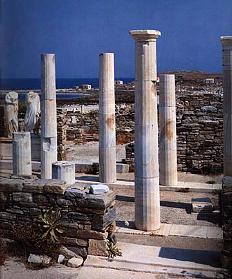 Apollo's mother was Leto, who gave birth to him on the island of Delos, which is located in the center
of the ring of islands known as the Cyclades because of their arrangement in a rough circle,
or kyklos (thus, Cyclades... also Cyclops, which means "round-eye" rather than, as most people
think, "one-eye"; this root word for roundness also gives us, of course, the English word "cycle").
According to some stories, the goddess Artemis was born on nearby Ortygia rather than on Delos along
with Apollo. Given the fact they were twins, this has always seemed remarkable to me. I mean, did
Leto get up and move, or what? In the midst of giving birth? Sometimes
those etiological myths, in this case a myth explaining why Delos is associated more closely
with Apollo than with his sister, can create some real puzzlers.
Apollo's mother was Leto, who gave birth to him on the island of Delos, which is located in the center
of the ring of islands known as the Cyclades because of their arrangement in a rough circle,
or kyklos (thus, Cyclades... also Cyclops, which means "round-eye" rather than, as most people
think, "one-eye"; this root word for roundness also gives us, of course, the English word "cycle").
According to some stories, the goddess Artemis was born on nearby Ortygia rather than on Delos along
with Apollo. Given the fact they were twins, this has always seemed remarkable to me. I mean, did
Leto get up and move, or what? In the midst of giving birth? Sometimes
those etiological myths, in this case a myth explaining why Delos is associated more closely
with Apollo than with his sister, can create some real puzzlers.
The word delos means "revealed," or "shown." According to some versions of the myth, this floating island sprang from the waves when Leto, chased by Hera, could not find a place that would give her refuge. Zeus asked his brother Poseidon, king of the sea, to intervene, so he revealed the tiny island of Delos. Because of its floating nature, it was neither land nor sea, and thus did not come under Hera's edict that prevented land or sea from sheltering the suffering Leto. As soon as she gave birth to Apollo (or to Apollo and Artemis, depending on which version you're taking), the island put forth roots and became fixed in place.
The palm tree that Leto clutched during her birth pains became an object of worship. All through ancient times there was a palm tree in the midst of Delos's sacred lake, and a palm tree was replanted there in recent years by French archaeologists, but the lake was drained about seventy years ago due to problems with mosquitoes. Now it looks like this.
Delos is an eerie site, with several acres of ruins remaining pretty much as its inhabitants left them when they were forced to abandon the place after repeated raids by Romans and local pirates. The pirates remained a notorious feature of the area until only about a century ago! Delos remains completely uninhabited today except for by a handful of members of the French School of Archaeology. According to the Wikipedia entry for Delos, the Greek census taken in 2001 claimed that the island had 14 inhabitants.
For a pleasant virtual walking tour of present-day Delos, visit the Traveling Classroom provided by GoGreece.com. Because this tour explores the ruins in spatial order rather than chronological order, you can get a good feel for how Delian society grew and developed over the centuries. Or if you want to see an incredible slide show that is less spatial but far more beautiful, try this one.
Because it's one of the few sites that hasn't been built over and resettled, Delos is an extremely rich source of archaeological information about everyday life and domestic architecture among the ancient Greeks.
Apollo's central sanctuary, however, was at the city of Delphi (note: that page has good information but is light on pictures, which is an odd choice because Delphi is quite possibly the most beautiful site in Greece. Here's a much better illustrated site with good pictures but not a lot of text). Delphi is also a rich source of archaeological information, at least about sacred architecture, because luckily for us the inhabited village is actually a mile or so up the road. The ruins of the temples and the stadium are virtually untouched. They are situated at the foot of Mount Parnassus, the traditional home of the Muses, of whom Apollo was the leader and patron. The daughters of Mnemosyne (memory), there were nine Muses altogether, each representing a different one of the arts, as shown in the table in Chapter 3 of Harris and Platzner. There's even a scientific Muse named Urania who represents Astronomy.
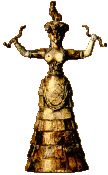 Apollo took control of Delphi through the
time-honored method of killing the previous owner, in this case a snake-like monster known as the Python, which is
why his priestess is sometimes known as the Pythia. This is often compared with ancient
Eastern myths of dragon-slaying, such as Marduk's conquest of Tiamat in the Babylonian epic
Enuma Elish. Other scholars, including Harris and Platzner, believe that this
legend shows remnants of a patriarchal religion taking over from a matriarchal one,
which might be evidenced from female figurines found in the Cycladic Islands (with
Delos in the center) and especially the famous "snake goddess" figurines
found on Crete. Yep, it's the Great Goddess idea once again.
Apollo took control of Delphi through the
time-honored method of killing the previous owner, in this case a snake-like monster known as the Python, which is
why his priestess is sometimes known as the Pythia. This is often compared with ancient
Eastern myths of dragon-slaying, such as Marduk's conquest of Tiamat in the Babylonian epic
Enuma Elish. Other scholars, including Harris and Platzner, believe that this
legend shows remnants of a patriarchal religion taking over from a matriarchal one,
which might be evidenced from female figurines found in the Cycladic Islands (with
Delos in the center) and especially the famous "snake goddess" figurines
found on Crete. Yep, it's the Great Goddess idea once again.
Don't you think it's ironic that according to our textbook Apollo, bringer of plague, has to take on a job as Admetus's shepherd to cleanse himself of miasma (the same word used in Sophocles' Oedipus the King to describe the plague that devastates Thebes) after he's killed the Python? I guess what goes around, comes around. I find this version of the myth more interesting than the version Euripides uses in his tragedy Alcestis, which is that Apollo was doing his community service on account of killing the Cyclopes who forged the thunderbolt that killed Asclepius. Same story, different motivation: Alcestis is Admetus's wife.
Whatever the case, maybe his displacement of a female deity at Delphi explains Apollo's rotten luck in love. Unlike Zeus, who has a remarkable success rate with the ladies even when he turns himself or the lady in question into an animal to escape Hera's notice, Apollo gets turned down so often by both divine and mortal females it seems almost humorous. In fact, it is rather humorous, considering he's supposed to be the most beautiful and attractive of the gods. Even when he falls in love with a young man who actually loves him back, the youth Hyacinthus, it ends badly. And then there's the whole Coronis story (Asclepius's mother), where Apollo had to zap her for sneaking around with a mortal behind his back.
The Trojan princess Cassandra and the Sibyl at Cumae went so far as to pretend to accept Apollo's advances in return for the gift of prophecy, but then they backed out of the deal after he'd given them what he promised. Funny, you never hear about Zeus having to promise anything in return for sex!
Working under the old prohibition that the gifts of the gods cannot be taken back, Apollo can only modify his promises so they become curses. Cassandra's prophecies are always accurate, but no one ever believes her. The Sibyl, who asked the god to grant her as many years of life as grains of sand she could hold in her hand, just fades away to become a prophetic voice in a bottle, a similar fate to that of poor Tithonus, who asked his lover, the goddess of the dawn, for eternal life but forgot to include eternal youth as part of the package deal.
One thing about Apollo is that--like most of the Greek gods--he is remarkably persistent. Perhaps the most important of his doomed love affairs concerns the nymph Daphne. Unable to take "no" for an answer, Apollo chases her until she prays to her father, a river deity, for help. Dad answers her prayer by turning her into the laurel tree. The word for laurel in Greek is daphni. Perhaps the most evocative statue of Apollo and Daphne is the one by the baroque artist Gianlorenzo Bernini--it really captures her desperation and his relentlessness.
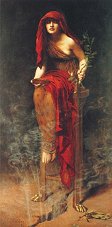 But even after his beloved has
had herself turned into a tree, Apollo doesn't
give up. He strips off
some of the erstwhile nymph's leaves and weaves them into a wreath, sanctifying the
plant as his own and thus creating the symbol of victory that is still familiar to
us today. The type of laurel that grows in Greece is poisonous, by the way, unlike the
English laurel, or bay, that produces leaves we use in cooking; when the
Pythian priestess chewed laurel leaves before making her prophecies, she might well have
had a case of mild poisoning that had something to do with her powers as an
otherworldly "seer."
But even after his beloved has
had herself turned into a tree, Apollo doesn't
give up. He strips off
some of the erstwhile nymph's leaves and weaves them into a wreath, sanctifying the
plant as his own and thus creating the symbol of victory that is still familiar to
us today. The type of laurel that grows in Greece is poisonous, by the way, unlike the
English laurel, or bay, that produces leaves we use in cooking; when the
Pythian priestess chewed laurel leaves before making her prophecies, she might well have
had a case of mild poisoning that had something to do with her powers as an
otherworldly "seer."
The painting to the right is a rendition of the Pythian priestess by the Victorian painter, John Collier. Click on her to bring up a larger version of the image. Notice the laurel leaves in the lower right hand corner and in the priestess's hand, and the dramatic depiction of the fume-emitting chasm that she supposedly sat over, even though no evidence of a chasm has actually been found in Apollo's temple at Delphi. It's mentioned in plenty of ancient sources, though.
She always sat on a tripod, by the way. The number three has been a sacred number throughout human history, probably because it is the number of stability. A three-legged stool will always sit steadily, while a four-legged chair or table has to be perfectly balanced or it will be wobbly. If you've ever had to shove a matchbook or wadded-up napkin under a wobbly table leg in a restaurant, you know what I'm talking about. Now, if I had to sit on a precarious stool balanced over a chasm, I would much prefer that it have three legs. While it's true that the priestess might need to claim workman's compensation after chewing too many of those laurel leaves, at least she was unlikely to hurt herself on the job by falling off her perch, even when she went into a trance.
Apollo is often seen carrying a lyre, to symbolize his role as the god of music. A popular theme for artists with a gruesome turn of mind is the story of Marsyas, the satyr who had the temerity to challenge Apollo to a music contest, with the Muses and King Midas as judges. Yes, this is the same foolish King Midas you heard about in the myth about the famous Golden Touch (or whom you may recall being played, not very accurately, by Kermit the Frog in the video on that subject). The Muses naturally chose in favor of their patron Apollo, but Midas was enchanted with the satyr's pan pipes and gave the honor to him. A sore loser, Apollo had Marsyas flayed alive. The errant judge got off somewhat easier: Midas had the ears of an ass bestowed upon him, and had to wear a turban ever afterward. Ovid, of course, covers this metamorphosis in his Metamorphoses, though he changes the competitor from Marsyas to the god Pan: you can find the story in Book IX, pages 303-305.
There are a number of graphic depictions of Apollo stripping the skin off Marsyas. Perhaps the most disturbing is Jusepe de Ribera's 1637 painting, which displays an eerie contrast between the earthy satyr's agony and the godlike Apollo's calm detachment. You just can't feel very warm and fuzzy about the god of enlightenment after looking at that thing. On the whole I prefer this picture, which shows Marsyas in happier days, enchanting bunny rabbits with the sound of his pipes.
Music and poetry are very closely allied in the ancient world, since professional storytellers, or bards, generally sang their stories to the accompaniment of the lyre. This is where the phrase "lyric poetry" comes from, and from that term we derive the idea of "lyrics" to a song. To end this piece on an uplifting note, here's some information about the lyre and its central place in the education and culture of ancient Greece. I find this idea rather inspiring, and definitely a solid argument for why Apollo, as the lyrical god, can lay claim to being the bringer of enlightenment.
To read more about Apollo, click here for the entry from the Encyclopedia Mythica, click here for Carlos Parada's overview of myths about Apollo in capsule form.

Return to the top of this page